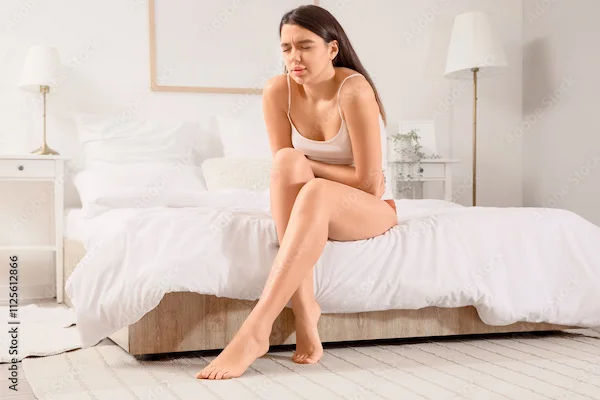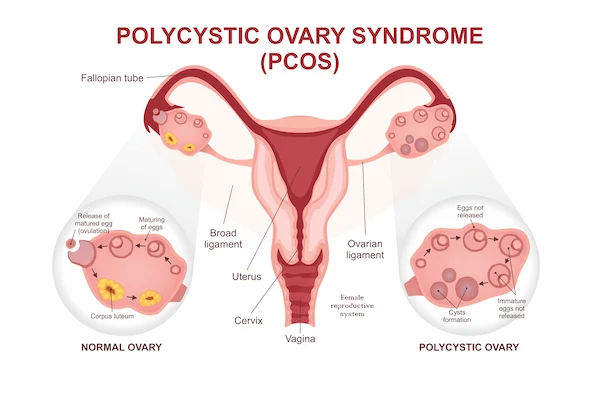How To Reduce Back Pain During Periods?
Back pain is a common symptom of menstruation flow which causes irritation and inflammation. Know the causes of back pain during periods and its treatments.

Written by
Last updated on 3rd Jul, 2025
Common Symptoms Associated with Period Back Pain
There are two types of period pain –
Primary Dysmenorrhoea
Generally, people with primary dysmenorrhoea experience pain from the start of their menstruation flow. It occurs due to period cramps. During menstruation, the uterus contraction detachs the tissue in the uterus lining. Prostaglandins, the hormone-like chemical messengers, cause this contraction and period cramps. When the uterine lining sheds during menstruation, the body releases prostaglandins. At that time, the chemicals help the body heal and alleviate the pain.
Secondary Dysmenorrhoea
Secondary dysmenorrhoea can occur due to numerous physical conditions. These include endometriosis, infections, fibroids, growths, and more. These conditions lead to lower back pain along with abdominal pain. Moreover, prostaglandins can increase the pain level of secondary dysmenorrhoea.
Moving on, menstrual back pain can significantly disrupt daily life, making even routine tasks challenging. The persistent aching or sharp discomfort in the lower back can lead to reduced mobility, affecting posture and movement. Simple activities like standing for long periods, bending, or lifting objects may become painful, forcing individuals to limit their physical exertion.
Lifestyle Adjustments to Relieve Back Pain
Here are a few tips about lifestyle adjustments that can ease back pain during the periods –
Regular exercises boost the release of natural endorphins, which help alleviate pain. If someone struggles to exercise due to lower back pain, try something mild, such as swimming or yoga.
Individuals should try to sleep in such positions that ease lower back pain. For instance, they can try putting a pillow between the knees or under the abdomen, etc.
Getting a back massage can also relieve back pain. This massage relaxes the muscles and enhances blood flow, lowering pain.
Alcohol, cigarette, and excessive caffeine consumption can worsen any pain related to the period. Thus, avoiding these habits can reduce back pain.
Apart from these, proper hydration and a balanced diet are vital in lessening lower back pain during the menstrual period. So, women should focus on eating plenty of vegetables, fruits, leafy greens, and anti-inflammatory foods to reduce lower back pain. For instance –
The anti-inflammatory compound curcumin in food items aids in reducing period cramps and bloating.
Magnesium and iron in dark chocolate also reduce period cramps.
Probiotics in yoghurt soothe period pain and improve mood.
Eating protein-rich foods can improve the body's energy level and minimise period pain.
Besides diet and lifestyle management, one needs to focus on relieving stress. Women can indulge in yoga and meditation or their hobbies to lower the anxiety of this phase.
Effective Home Remedies for Immediate Relief
Applying heating pads on the lower back can relieve back pain. Studies found that heat therapy can more effectively treat period pain than non-steroidal anti-inflammatory drugs (NSAIDs). One can use readymade heating pads or make her own. Here are simple steps to make the heating pads at home –
Cut two pieces of fabric and sew them together.
Leave a hole at the top and fill up with uncooked rice. Then, stitch up the hole.
To get the desired temperature, put it in the microwave for a few minutes. But don't overheat.
Finally, cool it if necessary and apply it to the affected area.
Also, individuals can prefer massage therapy for reducing menstruation pain, including back pain. A 20-minute massage therapy will be helpful this time. It involves pressing on the specific points of the body and the therapist's hand movements around the back, abdomen, and side. Again, there are options for aromatherapy. It includes massage with essential oils such as rose, lavender, fennel, and peppermint. These oils should be diluted with a carrier oil such as sweet almond or rapeseed.
Over-the-Counter Medications and Pain Relief Options
Based on the actual cause of the back pain, the healthcare provider may prescribe the following medications –
NSAIDs such as aspirin and ibuprofen dilute pain by reducing prostaglandins.
Birth control pills with progestin and oestrogen can reduce the pain. These are available in the form of pills, vaginal rings, and the patch.
Pain relief cream containing capsaicin that can relax pain.
Also, progesterone is a good pain reliever.
If the lower back pain is a cause of endometriosis, then the doctor prescribes gonadotropin-releasing hormone agonists to soothe the pain.
With the medications, they may refer the patients for specific medical procedures, if necessary. These include –
Endometrial Ablation: This procedure destroys the lining of the uterus. The goal of this surgery is to reduce the menstrual flow. In some people, it may completely stop the menstrual flow.
Endometrial Resection: It also demolishes the lining of the uterus.
Laparoscopy: The doctor removes endometrial tissue and checks inside it through this procedure.
Hysterectomy: It's a surgery that removes the uterus.
Consult Experts for Personalised Treatment
Alternative Therapies and Treatments
Acupuncture can be an impactful treatment as an alternative therapy. It involves inserting skinny needles into the different locations of the body. This procedure maintains the life force known as Qi.
A study conducted by Australian researchers showed that women undergoing acupuncture have experienced impactful improvements in period pains. Specifically, the researchers found that women who went through manual acupuncture experienced better decrement of pain and 50% reductions of symptoms than the women with electro-acupuncture.
Chiropractic adjustments and massage slightly improve lower back pain. Though there is limited evidence that it's a good treatment option for lower back pain, the American College of Physicians recommends this procedure for chronic and lower back pain. This treatment aims to improve the movement of the spine and reduce pain. So, the chiropractor uses instruments or their hands and applies quick pressure on the spinal joints.
When to Consult a Healthcare Professional?
One must consult a healthcare provider for severe lower back pain. It may indicate the underlying causes, such as pelvic inflammatory diseases or endometriosis. If there is no underlying condition, individuals should discuss medical and at-home treatment options with the doctor to reduce the pain.
Long-term Strategies for Managing and Preventing Back Pain
Self-care is the best strategy for lowering back pain during periods. So, individuals must follow these tips –
Regularly spending time on self-care activities like participating in a hobby, meditation, relaxation exercises, and spending time with family and friends can reduce back pain.
During working hours, one can take breaks to walk or stretch. These habits can help to manage back pain.
Plan and pack the natural elements that can effectively bring down the pain. These include essential oils or herbal tea.
The lower back handles the stress of balancing the upper body. Thus, the surrounding muscles of the back should be toned in such a way that they can support the spine and reduce the pain of the lower back. So, practising some simple core exercises will be helpful.
Avoid sitting in a poor posture or for long periods. It is essential to get up and walk around sometimes.
Conclusion
Every woman experiences back pain during periods, and it is not a serious medical condition. Individuals can easily manage it with some home remedies, dietary modifications and lifestyle changes. By eating nutritious food and engaging in mindful activities and exercises, people can get relief. But, if this pain lasts for a longer time, then consulting a doctor is essential to identify any underlying issue. Nevertheless, women should not panic during this condition and focus on doing the right things to get better.
Consult Top Gynaecologists
Consult Top Gynaecologists

Dr. Pallab Roy
Obstetrician and Gynaecologist
6 Years • MBBS, MS Obstetrics & Gynecology
Kolkata
Dr Pallab Roy, Kolkata
(25+ Patients)

Dr. Sreeparna Roy
Obstetrician and Gynaecologist
8 Years • MBBS , MS (OBSTETRICS & GYNAECOLOGY), Fellowship in Infertility, Endoscopy & Ultrasonography), Fellowship in Laparoscopy & Hysteroscopy,DRM
Kolkata
Dr Utsa Basu Clinic, Kolkata

Dr. Mona Yadav
Obstetrician and Gynaecologist
19 Years • MBBS, MD (Obstetrics & Gynaecology)
Dombivli
Nulife multispeciality, Dombivli

Dr. Sunabha K Ghosh
Obstetrician and Gynaecologist
9 Years • MBBS, MS (Obstetrics & Gynaecology), DNB (Obstetrics & Gynaecology), MIAGE, RCOG Associate [UK]
Kolkata
Gajanan Multispeciality Clinic, Kolkata

Dr. Debashree Saha
Obstetrician and Gynaecologist
4 Years • MBBS, MS (Obstetrics & Gynaecology)
Kolkata
DR. DEBASHREE SAHA Clinic, Kolkata
Consult Experts for Personalised Treatment

Dr. Pallab Roy
Obstetrician and Gynaecologist
6 Years • MBBS, MS Obstetrics & Gynecology
Kolkata
Dr Pallab Roy, Kolkata
(25+ Patients)

Dr. Sreeparna Roy
Obstetrician and Gynaecologist
8 Years • MBBS , MS (OBSTETRICS & GYNAECOLOGY), Fellowship in Infertility, Endoscopy & Ultrasonography), Fellowship in Laparoscopy & Hysteroscopy,DRM
Kolkata
Dr Utsa Basu Clinic, Kolkata

Dr. Mona Yadav
Obstetrician and Gynaecologist
19 Years • MBBS, MD (Obstetrics & Gynaecology)
Dombivli
Nulife multispeciality, Dombivli

Dr. Sunabha K Ghosh
Obstetrician and Gynaecologist
9 Years • MBBS, MS (Obstetrics & Gynaecology), DNB (Obstetrics & Gynaecology), MIAGE, RCOG Associate [UK]
Kolkata
Gajanan Multispeciality Clinic, Kolkata

Dr. Debashree Saha
Obstetrician and Gynaecologist
4 Years • MBBS, MS (Obstetrics & Gynaecology)
Kolkata
DR. DEBASHREE SAHA Clinic, Kolkata


